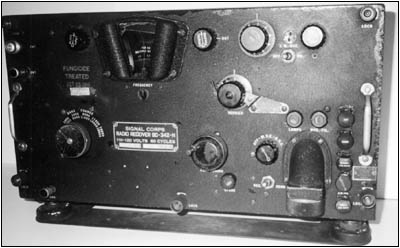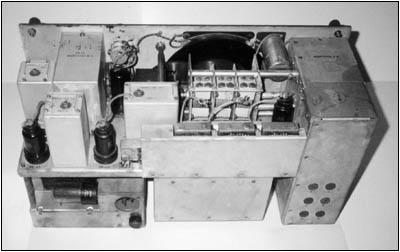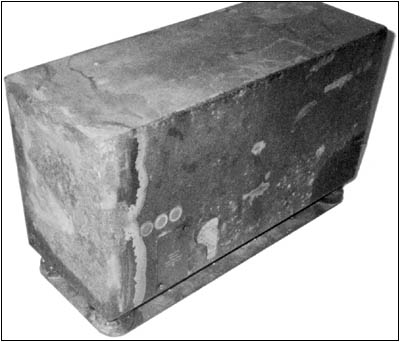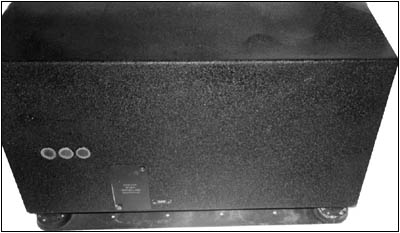Of Old Radios And Related Items--Published Monthly
Rebuilding the BC-342 Receiver
by Louis L. D'Antuono, WA2CBZ
Web Edition
The BC-342, a World War II military radio receiver, operates on AC power, unlike other military radios that use dynamotors for a power supply. Consequently, the BC-342 seems a good choice for new collectors of military radios. Louis D'Antuono tells how he brought one rusted hulk back to life. (Editor)
My interest in military receivers began in the early 1960s when I started to notice their use in the ranks of radio Amateurs and shortwave listeners. The thought of using electronic equipment that could have or did have wartime and possible actual combat experience seemed intriguing. The problem usually associated with military equipment is conversion which demands, in most cases, that the Amateur or hobbyist have some technical experience. This often means rewiring the filaments and building a power supply.
I consider myself a purist when it comes to converting military surplus receivers. This includes especially avoiding internal modifications, except those that enhance the original operation of the equipment. An example of this type of modification would be preventing backlash in the tuning mechanism. Moreover, I never use external tunable converters that detract from the standard tuning indicator. At best, I will use an audio filter or external crystal converter. Never would I change the outward appearance of the equipment.

Figure 1. My Signal Corps radio receiver, Model BC-342.
Frequently, I have shied away from converting and rebuilding military surplus receivers because they lacked an internal power supply. This is certainly true of most of this genre, but there are some exceptions. One of these anomalies is the BC-342 receiver. This radio was designed for military base installations where AC power was readily available. The result is that it makes the unit a good choice for restoration and a good compromise between antique radios and military surplus units. Despite this obvious advantage, the AC power supply will have to be completely checked out before starting restoration. This may mean the replacement of components due to age or defect.
Tube Complement
The BC-342 receiver contains ten tubes consisting of the following tube types: two 6K7s as RF amplifiers, a 6L7 mixer, a 6C5 local oscillator, two 6K7s as IF amplifiers, a 6C5 CW oscillator (BFO), a 6R7 detector/1st AF, a 6F6 audio output, and a 5W4 rectifier. The first audio stage contains the detector as well, integrated into one circuit.
Similar Radios
The BC-342 is similar to the BC-312 but the latter was designed for a 12-volts DC operation. For conversion, this receiver would need either 12 volts DC for its dynamotor or a separate AC power supply. In this series of receivers, there are also two low frequency models, the BC-314 and BC-344, which cover 150 to 1500 kilohertz. The first is designed for 12 volts DC and the second contains an AC power supply. The problem with these receivers is that they look alike, and unless they have the correct name plate, they are difficult to distinguish by casual observation.

Figure 2. A rear view of the BC-342's chassis.
First Sighting and Acquisition
The first time I saw a BC-342 receiver it was displayed fully operational in a surplus warehouse along Canal Street in New York City in the early 1960s. It was distinctive in its size, look, dial and rugged military appearance. In short, I was impressed.
Many years later, I saw the set in some quantity at Leeds Radio when it was located on Warren Street in downtown Manhattan. Another time was at a Hamfest in the Westchester County Center in White Plains, New York. When I worked at Radio Shack in Brooklyn, New York, a customer mentioned that he owned one. Despite all of these close encounters, I never came to own one until twenty years later.
Finally, in June of 2001, I saw one at a LIMARC Hamfest at Briarcliff College in Bethpage, Long Island. The radio is shown in Figure 1. The owner originally wanted twenty dollars, but when I noticed it was missing a few tubes after I took the receiver out of its cabinet, the price dropped to ten dollars. I was sold but I did not know if the radio worked.
Receiver Description
This receiver's tuning range is 1,500 to 18,000 kHz and has an IF frequency of 470 kHz. There are six bands, and the dial mechanism automatically masks the other five that are not in use. Tuning is accomplished with two separate knobs, one for a fast rate and the other for vernier adjustment. There are also controls for aligning the antenna input, crystal phasing and CW (BFO) oscillator zero beating. Another knob is a dual variable ganged control that combines AF gain with RF gain.
There are two toggle switches on the front panel, one for the CW oscillator and the other for a send/receive relay. The last control is a rotary switch that selects between On/Off and MVC or AVC modes. Fuses are accessible from front and rear panels.

Figure 3. The badly rusted cabinet was begging for restoration.
Restoration
One of the major drawbacks in restoring this receiver is its weight. It weighs in at approximately sixty pounds and moving it is made even more difficult because of its small equipment handles. Servicing could be made easier with the use of a wheeled cart to make moving it or turning it around more manageable.
As mentioned previously, the BC-342 receiver contains a built-in power supply. It also contains a rather husky power transformer with four secondary windings to meet all of the receiver's needs. There is one winding for the rectifier tube filament, another for the B plus supply, a third for the 12-volt tube filaments, and a final one for the 12-volt dial lamps.
The cabinets for this receiver were built with an opening on the rear panel for the AC connection. If the enclosure was used with the BC-312, a cover plate was included to cover this aperture. The entire power supply also swings out of the chassis for easy servicing. The B plus supply contains a full-wave rectifier, a rugged filter network consisting of two 8 mF electrolytic capacitors and an 8 Hy choke.
There is a bleeder resistor connected across the B plus supply output for safety, and it provides some voltage regulation. The power supply, however, lacks bypass capacitors in the primary circuit to inhibit AC line interference. A rear view of the receiver is shown in Figure 2. The power supply sub-chassis is shown at the lower left.
Finally, I bought the tubes that were missing and decided to fire up the receiver. I slowly applied AC power using a variac to protect the potentially leaky electrolytic capacitors. To my astonishment, the receiver worked, but there were shortcomings. There seemed to be some intermittent operation with the ganged RF/AF gain control, but this did not alter the unit's overall performance. The BFO seemed to be a little weak at times, but I still was able to copy Single-Sideband (SSB) and CW without any real difficulty.
Operating the crystal phasing control required some patience, but I finally got the hang of it. When listening to shortwave or broadcast stations, I found that the control could be taken out of the circuit by turning it completely clockwise. Overall, I was satisfied with the receiver's performance, but for Amateur radio use, I would have preferred more dial bandspread. The vernier tuning rate, however, was slow enough for Sideband or CW. These deficiencies did not detract from this unit's utility as a general coverage receiver.
Cosmetics
The final problem to be tackled in restoration was the cabinet's poor condition. On closer inspection, it appeared that the right side of the enclosure had been lying in water. It was badly rusted, as Figure 3 indicates, and it needed to be sanded down and painted to restore it to its original finish.
I had to be careful because inside the cabinet there was a metal plate with a schematic and parts listing. Using only a metal brush and sandpaper were ineffective in solving this problem. A power sander was much more effective. I used it until the cabinet was completely smooth and free from rust. Then I applied a coat of primer paint to prepare it for refinishing. Finally, I painted it with black wrinkle finish paint. Using a heat lamp helped to increase the wrinkling.
Replacing the missing glass in the original dial opening took some time to accomplish. Then I replaced the missing nameplate making sure it was the correct model number. Finally, I replaced any damaged phone jack covers making sure they had the correct labeling. Figure 4 shows the restored cabinet.

Figure 4. The restored cabinet after the sanding, priming, and painting operations.
References:
Black, Guy. "Power for the BC-312." Radio-Craft, January, 1948.
Bucklin, K. G., W2CDP. "Curing Back-Lash in the BC-342." QST, June 1952. (Hints and Kinks).
Duvall, Dennis L., WA3YXN. "The BC-312/342 Receivers." Electric Radio, #95, March, 1997.
Duvall, Dennis L., WA3YXN. "Update on BC-312." Electric Radio, #103, November, 1997.
Evenson, R.C. and Beach, O.R. "Converting the BC-342 Receiver." Surplus Radio Conversion Manual, #1, Second ed., 1948.
Grammer, George, W1DF. "Revamping the BC-342." QST, September, 1946.
Morrison, Howard L., W7ESM. "Phone Selectivity for the BC-312." QST, February, 1954.
Orr, William I., Ed. "The BC-312 and BC-342 Series Receivers." Surplus Radio Conversion Manual, Volume #3, 1960.
Rand, Philip S., W1DBM. "The Q5-ER." QST, December, 1947.
Smith, R.M., W1FTX. "Further Improvements in the BC-342." QST, August, 1952.
(Louis L. D'Antuono, WA2CBZ, 8802 Ridge Blvd., Brooklyn, NY 11209)
Louis L. D'Antuono holds an Extra Class Amateur radio license. He is a Social Studies teacher at the James Madison High School in Brooklyn, New York.
| [Free Sample] [Books, etc., For Sale] [Subscribe to A.R.C./Renew] [Classified Ads] [Auction Prices] [Event Calendar] [Links] [Home] [Issue Archives] [Book Reviews] [Subscription Information] [A.R.C. FAQ] URL = http://www.antiqueradio.com/Nov03_DAntuono_BC342.html Copyright © 1996-2003 by John V. Terrey - For personal use only. Last revised: October 4, 2003. For Customer Assistance please contact ARC@antiqueradio.com or call (866) 371-0512 Pages designed/maintained by Wayward Fluffy Publications
Antique Radio Classified |